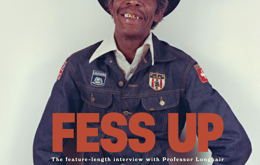
Enrico Di Donato has a lot on his mind. “This is one of mankind’s oldest topics,” he says. “I started with this concept of revenge, the balance between yin and yang, and when does an act of justice become one of revenge?”
Those aren’t subjects you expect to hear pondered at a trade show, let alone the world’s largest music industry trade show, a stone’s throw from the Happiest Place on Earth. But Enrico was commissioned by NAMM (the National Association of Music Merchants) to create installations for this year’s show, one of which greeted visitors to the Boutique Guitar Showcase area at the Anaheim Convention Center. He made certain his installation grabs viewers: “There is this panel made out of leather,” Enrico explains, “with all this fake blood.” His inspiration was the Quentin Tarantino film Kill Bill. The bloody backdrop frames two of Enrico’s remarkable guitars, each also referencing the film. “One is the Beatrix axe,” he says, “and the other is the Bill.”
I first met Enrico at the 2017 NAMM Show. The guitars he creates in Venice, Italy were unlike any I’d ever seen: an aluminum frame holds a thin soundboard, mounted in a way to minimize contact with anything that could constrict the soundboard’s responsiveness. “The only thing to touch the body is the bridge to transfer the vibrations,” he says. It’s a radical design, cool looking in the extreme yet focused on optimizing the acoustic potential of a piece of wood.

That’s the sort of creativity that abounded at the 2018 Winter NAMM Show, thanks to the designers-builders present in the Boutique Guitar Showcase and the
new Luthiers Beyond Limits gathering. A plethora of the world’s most creative guitar makers were there to discuss their artistry and show their work. Stunning work it is, too, pushing the envelope visually of what a guitar can be as well as enhancing how instruments sound and feel.
The luthier’s task is complex: hours of labor go into delivering an instrument’s visual statement, yet that’s secondary to its sound. A good looking and sounding guitar will only find a home if it feels great to play, too. The visual, the aural, and equally important the tactile: guitar makers have many fields to balance. Emphasizing one at the expense of the others could turn them into minefields.
Steve Klein has been treading those fields for a half century now. “The label in my first little acoustic guitar was 1967,” he says. Luckily, Steve was in the right place at the right time to embark on his journey as visionary guitar maker. His maternal grandfather was a research chemist at UC Berkeley. He took a teen’s guitar-making aspirations seriously enough to introduce him to visiting professor Michael Kasha. Kasha was applying research in molecular biophysics to guitar making. He determined that classical guitars only convert about 5% of string vibration to sound. Kasha, in tandem with luthier Richard Schneider, redesigned the bridge and bracing for nylon string guitars to deliver more sound. Steve was eager to apply their principles to steel string acoustic guitars, but Kasha was not encouraging. Schneider, however, inspected the fourth guitar Steve made and proclaimed, “Congratulations! You’re a guitar maker.”
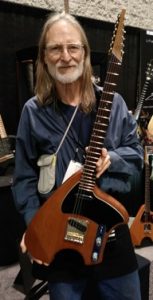
Steve was also place-and-time right to get his work to influential musicians. He hung out at Fillmore West (“Bill Graham would ask me, `Who are you?’”), looking for feedback on his guitars from star players. When the likes of Stephen Stills and Joni Mitchell began performing and recording with his instruments, Steve became a rock star among innovative guitar makers.
His rep was made on big beautiful acoustics, but Steve isn’t basking in past glory. Today he’s excited about a new solidbody electric design he’s calling sTele (“Small s, capital T,” he insists).
“That’s my real focus now,” he says. “It’s basically an ergonomic Telecaster.”
What makes it ergonomic?
“It’s how it sits with the body,” says Steve. “The vast majority of all guitars, the centerline of the neck in relationship to the waist of the guitar, when you sit down with it the guitar neck is parallel to the floor. Nobody plays that way, unless you really have bad posture or you want to ruin your body. So rather than struggle, the design has been modified so that where it rests on your leg automatically holds the neck in the proper place.” To prove his point, Steve sits down with a sTele balanced comfortably on his right leg. “I’m not struggling to hold the neck up or push anything down,” he says. “The guitar’s hard enough to play as it is, you don’t want to struggle holding it. Now everything’s in perfect playing position.”
In that context the sTele’s seemingly odd body shape makes perfect sense, as does Steve’s choice of tonewood. “I’m using a lot of redwood for the body,” he says. “Redwood has the highest stiffness-to-weight ratio of any wood. It’s not only light, it’s exceedingly resonant. You’re not holding a lot of weight, and it’s a really responsive instrument. Makes you want to just put a microphone in front of it rather than plug it in!”
Steve has not shied away from decorative flourish in his past work, but his sTele is pure functionality, stripped to essentials. “The concept is to limit material,” Steve explains. That’s especially evident in the guitar’s striking javelin point headstock: “Less wood. What is normally the weakest part of the guitar is now the strongest,” says Steve. “I don’t have a wide paddle of a headstock, like a Gibson, that always breaks off. Plus, you’ve got the longer bass string [the opposite of the standard electric headstock setup], so, physically, it’s better when you drop down in different tunings. The tuners are facing back at you, so you’re not having to raise your elbow and shoulder or drop them to tune the instrument. It’s more ergonomic.” Form follows function.
Yuki Nishigaki has been living only half as long as Steve Klein has been making guitars. Yet the two have one thing in common: both had grandfathers who played key roles in leading them towards guitar making. Yuki’s was a carpenter in Japan; he worked wood in old ways with vintage equipment. This sparked Yuki’s interest in woodworking and, ultimately, guitar making. He was just fourteen when he built his first, an electric. He studied advanced guitar making techniques at twenty, and quickly made a name for himself in Japan with his archtop guitars. I interviewed Yuki with translation help from guitarist Yuto Kanazawa. “That became his identity,” Yuto said of the archtops, “and was a turning point.”
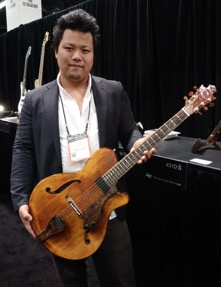
Indeed, you could call it a meteoric rise—only 25, Yuki presented his work at NAMM alongside the world’s master guitar makers. Search YouTube for Nishgaki Guitars (for reasons unknown to me his guitar line drops the second `i’ in his surname) and you’ll find a variety of Yuki’s guitars demoed courtesy of a Japanese music store or distributor named Blue Guitars. I wondered if he made all those labor-intensive archtops alone. “From selecting the woods and then building the guitar and then taking them to the customer,” Yuto said, “he’s doing it by himself.” And he discreetly puts a lot of Japan into his instruments.
“He wants to express Japanese culture making guitars,” Yuto tells me. “This guitar [Yuki’s archtop, named Arcus] is made using all Japanese wood. Top is kiso hinoki, which is Japanese spruce. The back and neck are Japanese maple, and the fingerboard Japanese persimmon. The tailpiece, pickguard, and headstock are Yoshino Sugi, Japanese cedar. This wood is used for making shrines in Japan. [Japanese cedar is the national tree of Japan, often planted at temples and shrines.] This color, the finish, is made by a Japanese traditional art called Urushi.
It’s a traditional type of Japanese lacquer, which I’ve never seen on another guitar.”
Yuki brought two guitars to NAMM, his Arcus archtop and a thinline electric he calls Cirrus. The Cirrus likewise uses Japanese woods and another distinctive finish: “Color is added by Japanese traditional Suiboku [ink-and-water painting],” Yuto explained. “It’s brushwork, blended really well, so the black looks a little green.”
If Yuki weaves Japanese tradition and materials through his work in subtle yet assertive ways, Japan is referenced overtly in what Serge Michiels proudly calls “the eponymous Tao guitar.” Brussels-based Tao Guitars are Serge and John Joveniaux. Their work is bold, brilliant, and at times a mite whimsical. The namesake Tao electric has Japan writ large all over it. “This is a mix of the Japanese instrument called the Biwa,” says Serge, “which is a Japanese lute. This is a cross between ancient Japanese craft and real modernistic design influenced by the dear Steve Klein, who is one of our idols. So you have a shamisen-influenced headstock and the particularity also of this guitar is you don’t have any cavity. The electronics are mounted in a certain way we call `the ship in the bottle.’ You have to drag every wire inside so you have a full look of the body without any plates or anything. You have also in Japanese what is called the Bashimen [pickguard]. This is made with washi paper. Washi paper is made out of wheat, grain, fruits, this is traditional Japanese paper. These pickups are Benedetti, double blades. You have the bridge coil inside the bridge. The covers are made of Paulownia, the wood for Japanese furniture. It’s burned like the old Shou-sugi-ban [charred wood] technique from Japan.” The Tao is a painstaking labor of love, a multi-layered homage to Japanese culture from two Belgians.
Serge and John also brought two other stunning beauties to NAMM, foremost the fabulous Phaeton: “Our flagship model,” says Serge, “the most luxurious, expensive [$28,000] guitar we make. It’s made like a style 0-3 by Orville Gibson.” Equally eye catching is what Serge calls “the little sister, which is the Disco Volante. It’s more like our view of a Les Paul. But it’s hollowed out, it’s quite light, and you have a nice flame top. You have a back and neck in Spanish cedar, so it’s really lightweight, really resonant. You have our own pickups, also designed by us and Benedetti in France, which are called the Double D.” As Alfa Romeo fans will note, the Disco Volante name frankly acknowledges the influence of Italian car design on the Tao Guitars sensibility.

Guitar builders who pay homage to iconic American models are so abundant that they hardly seem worth noting. But Germany’s Rainer Tausch offers elements both original and regional to enhance classic American designs. “I wanted to push the talents of a Telecaster a little bit,” he says of his 665 guitar. “The body is made of one piece of pear wood, and it’s semi-hollow. It has sound chambers on both sides and an end-to-end block in the middle, so the full length can resonate. And you have chambers to make the guitar light. It’s a quite light guitar. Compared to a Telecaster it has a set-in neck, not a bolt-on neck. The neck itself is a little bit longer. It has a 26 and three-16ths scale. I only know in centimeters. The Strat scale is 25-and-a-half, so this one is 1.8 centimeters longer, which brings a little bit more twang into the sound.
“Something which is necessary for me, the fretboard on this guitar is made from plum wood. It just looks like rosewood. It’s plum wood grown in Germany, same thing with the pear wood for the body. The maple [neck] comes from Bosnia, which is Europe. Using local woods on the guitar saves our resources.
The pickups are German made by Harry Häussel, a very famous pickup winder in Germany.”
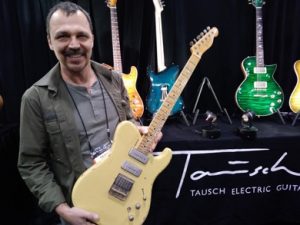
Rainer also builds a variant of another American classic. “I call it 659,” he says. “It’s for those who already have Les Pauls at home, and they want something different. The scale length is an extended Les Paul, making is just the same as the 665 one. It’s also a semi-hollow chambered body. In this case it’s made out of walnut. It’s the same thing, to save resources. The fretboard is also plum wood, and there is a pair of Häussel pickups in it. They are called the 1959, so you get this sweet tone. He took the right material, just right. They really have the sweet tone you expect from a Les Paul. But you cannot compare it to a Les Paul, because it is much bigger. It is 5% in every direction more.
And it has this longer scale, so it sounds a little more fresh.”
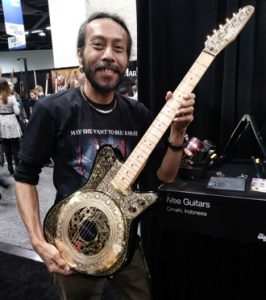
If you were to imagine a land where a luthier would feel driven to reinvent resonator guitars, born in Jazz Age Los Angeles and later imbued with Southern blues spirit, the first country to come to mind might not be Indonesia. But that’s Ivan Mulia’s homeland, where resonator guitars were scarce. “From a long time ago I really wanted to have my own resonator guitar,” he says. “I couldn’t find one, so nine years ago I said, `Why don’t I start making them myself?’ My main work is in an aluminum casting workshop. The materials I use are aluminum and brass.” The Java-based luthier makes his guitar necks from local woods. “This one is Sonokeling,” he says, “it’s kind of like Indonesian rosewood.” Ivan brought four electric guitars to his first NAMM show, all dazzlingly engraved and essentially unique. “I never make the same twice,” he says. “Every one tells a story.” The one reso-electric he brought was adorned with designs, Ivan says, distinct to “a place in my country called Aceh Gayo [in Sumatra]. These are the ornaments from that culture.”
A muscular dragon slinks across the surface of another of Ivan’s guitars, instruments juxtaposing the mythos of the land of the Garuda and intricately patterned textiles, batik and songket, with that of an instrument long associated with American blues. It’s a heady (if unlikely) blend that requires a range of technical skills: Ivan may first sketch an idea onto paper, then work out its details on computer. When he has exactly what he’s after he transfers the images to film, providing a template for etching into metal. Simultaneously high tech and intensely hands on, Ivan’s work references a Les Paul or a tailpiece you think you’ve seen on a vintage Gibson, only the context in which he frames the familiar makes you view it in unexpected terms. Ivan may be an accidental surrealist, upending conventional reality from a Javanese aluminum casting workshop. He’s making waves, too: following his first NAMM show he presents his work in May at the prestigious Holy Grail Guitar Show in Berlin. Back home he’s a celebrity: thanks to YouTube you can watch Ivan on an Indonesian talk show where comics maul his guitars, pretending to play while shouting “Blues! Blues!” Throughout, Ivan evinces Zen-like calm.

If Ivan’s iVee Guitars seem grounded in earthy metal and mythology, the work of Canada’s Mike Sankey appears ready to take flight. In contrast to Ivan’s detail-drenched dreamscapes, the negative space and clean lines in Mike’s work soothe the eye and suggest the natural vastness of Canada. His more abstract instruments, such as the one he named Breaking Wave and calls “an asymmetrical headless wedge-bodied, very modernist kind of archtop,” may seem the most anxious to become airborne, but I was drawn to the opulent austerity of a more traditional looking guitar he named Odalisque.
“It’s a modern interpretation of what an archtop guitar can be,” says Mike. “Every guitar I make, like the ones here, they aren’t models: They’re individuals. This is an archtop acoustic guitar with an Englemann spruce [from British Columbia] top and black walnut, from up where I live, back and sides. The tailpiece, the bridge, the finger rest, the fretboard and the headpiece are all very stripy ebony from Indonesia. It’s made by a unique construction method that allows the top to be really light and responsive.
“The structure of the instrument is that a backbone runs from the neck all the way to the tail of the body. Both the neck and the tailpiece bolt to that, so that takes the stress of all the string tension, one hundred and twenty pounds or so of string tension there, which frees up the top to vibrate easily, `cause all it has to do is produce sound. It doesn’t have to be as structurally important anymore, so it can concentrate on doing its job, which is to vibrate in response to the strings.” That energy transference may add to the airy aura generated by Mike’s stunning guitars.
The luthier’s lot would seem to be a lonely one, one reason it’s refreshing to encounter a team of builders who are also married, Switzerland’s Claudio and Claudia Pagelli. Another is that the Pagellis are as personable as they are creative. Claudio makes introductions: “This is my wife, Claudia; she’s doing the designs and I’m doing the rest of it.” Claudia smiles and adds that the ollaborative aspect of their work is continuous while bringing a guitar to life. “At the end, we’re both together,” she says. “We need each other to get the instruments like that.”
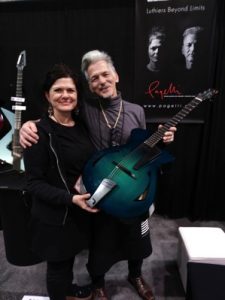
The fruits of this musical marriage are varied, ranging from archtopped elegance to zany electric abstractions. “This electric guitar was made for Billy Gibbons of Z.Z. Top,” says Claudio. “We will deliver it tomorrow. He called us and he wanted to have a guitar from us. He just said, `It has to be light,’ and he gave us the neck dimensions. And the rest, he wanted to be surprised. He was blown away!”
The swooping wide angular electric boldly references Googie architecture: think `The Jetsons,’ or, if you’re an Angeleno, the Norm’s on La Cienega. Hints of Googie are designed more subtly into the Pagelli’s acoustics, notable for their gorgeous finishes. “We love colors, “ says Claudio. “I’m into colors, so is Claudia. Of course we also make with natural nice wood, vintage finishes, but when we are doing it for ourselves, we are always into colors.”
A brilliant turquoise-to-deep-space-blue sunburst finish radiates from the Pagelli’s archtop. “This is our high end instrument,” says Claudio. “It’s called the Massari, a limited run of twenty guitars. I live in Switzerland in the Alps, and there you get access to the best spruce worldwide. The top is made of spruce out of the area where we live. So we have Alpine spruce, moon cut in the right moon season. `Moon cut’ is an old tradition that spruce is cut in the second week after the full moon where the tree is in the quietest period, and then they cut it. This wood, they say, is more stable and stiffer and sounds at the end better. The back, sides, and neck are European flamed maple, and everything that is black on it is ebony: the f-holes, inlays, everything.”
Is lutherie a calling? It’s likely Michihiro Matsuda would answer in the affirmative. He was nearly 30 when he left his native Japan for America, intent on mastering the craft of guitar making. He apprenticed three years with the esteemed Ervin Somogyi, who calls Michihiro “a phenomenon,” his work “remarkably original.”
Michihiro makes beautiful acoustic guitars prized by fingerpickers, but he also pushes the envelope with edgy electric designs. He brought the prototype of one he calls Deconstruction to NAMM. “This one was a special project,” he says. “There is no soundbox, just a soundboard. The first idea came from when I was a kid, I was playing with a little plastic thing [toy instrument]. When I bent it, the tension created more volume and a more interesting tone. I thought it might be interesting to apply the idea to a guitar soundboard. This has a double soundboard: the top is spruce but the back is balsa. In between is Nomex, it’s a honeycomb material. Then I twist bend it. So that’s the soundboard. It has no side and back, but it has a framework that supports the neck.”
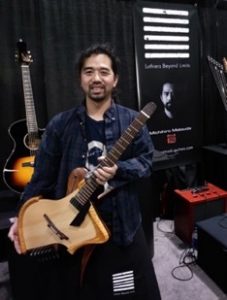
Michihiro’s Deconstruction scarcely looks like a guitar, yet I saw and heard someone play it convincingly at NAMM, delivering the statement, `This, too, is a guitar!’ No doubt expert luthiers embark on experiments that fail, but those that don’t could become the conventional guitars of tomorrow.
In an era when it’s easy to feel overwhelmed by ugliness and distraction, it’s inspiring to encounter intensely focused people, intent on creating works of beauty that are also tools that sound good. If, in so doing, they challenge our assumptions of what the guitar is, there’s a better than even chance we’ll one day thank them for that.
 Baja Review A community newspaper serving Ensenada, Valle de Guadalupe, and Rosarito in Northern Baja California
Baja Review A community newspaper serving Ensenada, Valle de Guadalupe, and Rosarito in Northern Baja California



